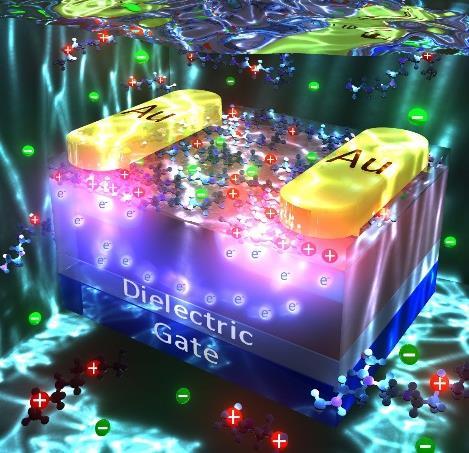[October 31. 2019] Engineering energy band structures in organic and hybrid semiconductor devices using non-conjugated polyelectrolyte films
| Speaker | Asst. Prof. Bright Walker(Kyung Hee University) |
|---|---|
| Date | Thu. 31 October. 2019 |
| Time | 5:00pm |
| Venue | #331, Asan Hall, College of Science |
Engineering energy band structures in organic and hybrid semiconductor
devices using non-conjugated polyelectrolyte films
Conjugated polyelectrolytes have long been known as effective interfacial layers in a variety of organic optoelectronic devices such as LEDs, solar cells and transistors. More recently, molecular electrolytes have been shown to cause doping in organic semiconductors. This talk reviews recent work done using non?conjugated polyelectrolyte (NPE) layers to achieve controlled N-type and P-type doping at interfaces in organic and hybrid electronic devices. To enhance electron injection in n-type organic field-effect transistors (OFETs), NPE layers were interposed between a [6,6]-phenyl-C61-butyric acid methyl ester (PCBM) layer and Au electrodes. NPEs based on an ethoxylated polyethylenimine (PEIE) backbone with various counterions including Cl-, Br- and I- improved electron mobilities up to ~10-2cm2 V-1s-1 and yielded on-off ratios (I on /I off ) of 105 in PCBM OFETs. Ultraviolet photoelectron spectroscopy (UPS) revealed that all of the NPEs reduced electron injection barriers (φe) at the NPE/metal interface. Absorption measurements suggested n- doping of the PCBM. Regardless of the type of anion, thick NPE layers led tohigh conductivity in the films independent of gate bias, whereas thin NPE layers led to dramatically improved electron injection and performance. This mechanism was further applied in perovskite solar cells and light-emitting solar cells. Cationic and anionic polyelectrolytes were able to improve electron and hole injection in perovskite solar cells by analogous n-type and p-type doping mechanisms, respectively. These results demonstrate that thin electrolyte layers can be used to achieve controlled doping at interfaces in organic and hybrid semiconductors.

Articles
-
 Fall semester 2016 Seminar Schedule
Fall semester 2016 Seminar Schedule
-
 Spring semester 2017 Seminar Schedule
Spring semester 2017 Seminar Schedule
-
 [Fri. 17 Mar. 2017] 9th RINS Symposium
[Fri. 17 Mar. 2017] 9th RINS Symposium
- [Thu. 27 Apr. 2017] Seminar was canceled!
- [Wed. 5 July. 2017] Seminar is canceled!
-
 7th Jilin-Korea-Waseda Alliance Annual Symposium
7th Jilin-Korea-Waseda Alliance Annual Symposium
-
 Fall semester 2017 Seminar Schedule
Fall semester 2017 Seminar Schedule
-
 Fall semester 2018 Seminar Schedule
Fall semester 2018 Seminar Schedule
-
 Spring semester 2019 Seminar Schedule
Spring semester 2019 Seminar Schedule
- Announcements Graduate Seminar Spring Semester 2021
- Announcement for Graduate Seminar Class, Fall Semester 2020
-
 [October 31. 2019] Engineering energy band structures in organic and hybrid semic...
[October 31. 2019] Engineering energy band structures in organic and hybrid semic...
- June 10th (Fri) Graduate Seminar / Bing Zhang, Ph.D.
-
 2022 International Symposium on Bioactive and Bioengineering Materials
2022 International Symposium on Bioactive and Bioengineering Materials
-
 2022 International Symposium on Chemical Applications of Machine Learning
2022 International Symposium on Chemical Applications of Machine Learning
- 2023 Germany-Korea On-Site Plenary Discussion on Computational Electrochemistry
-
 [October 10, 2017] Novel Terahertz Spectroscopies
[October 10, 2017] Novel Terahertz Spectroscopies
- [August 14. 2019] Principle of Semiconductor Quantum Cascade Laser and It’s Appli...
-
 [October 25, 2017] Ultrafast electron microscopy: applications in chemical and ma...
[October 25, 2017] Ultrafast electron microscopy: applications in chemical and ma...
- May 11, 2023 (Thu) Dr. Changyeol Lee
Designed by sketchbooks.co.kr / sketchbook5 board skin